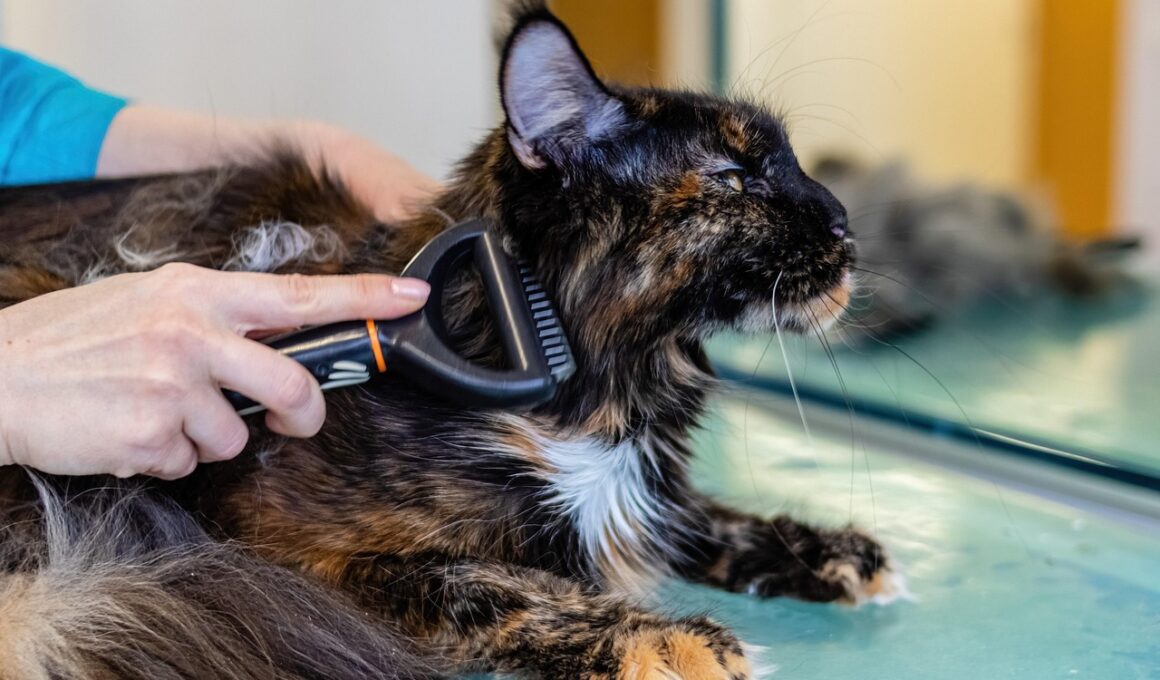How to Trim Your Kitten’s Fur at Home Safely
Grooming your kitten at home can be a rewarding experience, but it’s essential to approach it safely. Start by choosing the right tools for the job. A pair of high-quality, cat-specific clippers is essential for the best results. Regular brushing is vital in keeping your kitten’s coat healthy and manageable. Before starting, ensure your kitten is calm and comfortable. Some kittens may become anxious, so take breaks if needed. Always check the blade of your trimmers to make sure it’s clean and sharp. Dull blades can tug at the fur, causing discomfort. It’s advisable to conduct a patch test on a small area to see how your kitten responds. Ensure you have treats on hand to reward your furry friend for their patience. This will help reinforce positive behavior during grooming sessions. A smooth, non-slip surface can make this process easier and safer. Provide enough space where your kitten can move around without feeling trapped. Coordination between your hands and the clippers will also help in achieving a neat trim.
Next, familiarize yourself with your kitten’s coat type to make appropriate decisions regarding trimming. Kittens can have various fur types, including short, medium, and long. Each coat type might require different grooming techniques. For kittens with long hair, consider using specific clippers designed for thicker coats. Grooming should reduce shedding while also discouraging matting. Monitor how much fur you remove; it’s better to take off small amounts gradually. Observe your kitten’s behavior during this process. If they show signs of stress, take a break and reassure them with gentle strokes and soothing words. Furthermore, pay attention to problem areas where mats tend to form, under the belly and behind the ears. Using a detangling spray designed for pets can assist in preventing mats from forming. If your kitten has particularly stubborn knots, a specialized comb for cats can help. Be gentle around sensitive areas, and always be ready to stop grooming if your kitten becomes uncomfortable. Patience is key to making the grooming experience enjoyable. Over time, your kitten may learn to enjoy their grooming sessions.
When it comes to trimming your kitten, maintaining safety should be your top priority. Always keep a focused eye on your kitten to avoid any sudden movements that could lead to accidental cuts. Start by trimming small areas, allowing both you and your kitten to adapt to this new routine. Enlist the help of someone you trust to hold your kitten and keep them calm, if necessary. Additionally, high-value treats can be used to create a pleasant experience. Taking the time to reward your kitten will foster a more positive association with grooming over time. If your kitten struggles to stay still, consider using a harness designed specifically for pets. They help keep your kitten in one place but ensure it’s not too tight. Moreover, don’t overwhelm your kitten with too much grooming in one session. Breaking it down into shorter sessions can make a significant difference. Each session should take no more than 10 to 15 minutes, allowing for acclimatization. After you finish, thoroughly check for any areas that may need further attention and give your kitten lots of affection.
Understanding Kitten Behavior During Grooming
The behavior of your kitten during grooming is highly informative. Some kittens might initially resist grooming due to fear or unfamiliarity with the process. Recognizing these feelings is crucial. Observing your kitten’s body language, such as flattened ears or a swishing tail, can help gauge their mood. Always remain calm and reassuring, as your energy can influence their reaction. It is vital to sing softly or talk to your kitten during grooming to ease anxiety. Start with gentle strokes on their back, as most cats prefer this area to be touched. If they react negatively, stop and reassess your approach. Modifying your grooming strategy can greatly reduce negative feelings. Also, incorporate regular grooming sessions into your routine to create familiarity. Engaging in this ritual regularly can desensitize your kitten to the process, making them more tolerant over time. Consistency will yield better long-term results in making grooming a less stressful experience for both of you. Providing plenty of breaks will allow your kitten to relax and return to the process when they feel settled.
A comfortable grooming environment can significantly affect your kitten’s experience. Select a quiet, familiar spot in your home devoid of distractions. Allow your kitten to explore the area first, fostering their sense of security. Additionally, an orthopedic pet mat or blanket can provide a soft surface that adds to their comfort level. Ensure the grooming room is well-lit, so you can see what you are doing, thereby enhancing precision. It’s essential that both you and your kitten feel at ease in this space. Play some soft music if it helps in calming nerves; this can promote a peaceful atmosphere. The right environment will decrease your kitten’s anxiety and encourage a more enjoyable grooming time. Furthermore, prevent interruptions during your grooming session. Adjust the climate if necessary, as temperature can impact your kitten’s comfort level. Pay attention to your kitten’s behavior and adapt your grooming frequency accordingly. For instance, sensitive kittens may require shorter sessions more often, while others might be okay with longer durations. Maintaining a consistent grooming schedule tailored to their needs will further enhance their comfort.
After you finish trimming your kitten’s fur, rewarding them is crucial. Immediately offer their favorite treats or playtime to create positive associations. Following a grooming session with affection helps reinforce this behavior positively. Their experience should end on a high note, leading to lower chances of anxiety during future grooming sessions. Additionally, inspecting their skin for any issues, such as redness or irritation, is vital. Keeping your grooming tools clean and well-maintained is equally essential. Regularly disinfect your clippers and brushes to avoid infections and ensure a safe grooming experience. Provide your kitten proper hydration to refresh them post-grooming. This is especially important if you’re using clippers that may cause overheating. Lastly, always remember to keep an open line of communication with your veterinarian regarding grooming practices. They can provide valuable insight tailored to your kitten’s breed and unique needs. Consulting them is fundamental to ensure that your kitten’s grooming routine is both safe and effective.
Conclusion: The Benefits of Regular Grooming
Regular grooming sessions benefit both you and your kitten greatly. Not only does it help maintain their fur, but it also fosters a deeper bond between you and your feline friend. In addition, groomed kittens often exhibit lower levels of anxiety and discomfort linked with matting and tangling. Furthermore, keeping up with grooming habits reduces hairballs and shedding in your home. Establishing routine grooming also helps your kitten become comfortable with handling, increasing their social adaptability. This increased sociability affects vet visits positively, as stressed kittens tend to be more manageable. Moreover, regular checks during grooming allow early detection of skin issues, parasites, or abnormalities, enabling timely medical action if necessary. With consistent effort, your kitten will likely develop a love for grooming sessions, making this experience a real joy. Building trust through regular grooming can transform a daunting chore into a cherished ritual. This transition requires patience, but the outcome is a happy, well-groomed pet. In conclusion, prioritize safe grooming practices, environment preparation, and developing trust while nurturing their beautiful coat.


